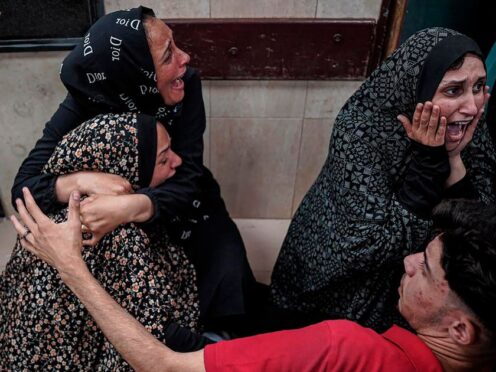Israeli forces are battling Palestinian militants across the Gaza Strip, including in parts of the devastated north that the military said it had cleared months ago after Hamas exploited a security vacuum to regroup.
Israel has portrayed the southern Gaza city of Rafah as Hamas’s last stronghold, saying it must invade in order to succeed in its goals of dismantling the group and returning scores of hostages.
A limited operation there has expanded in recent days, forcing some 300,000 people to flee.
But the rest of the war-ravaged territory seems to provide ample opportunities for Hamas. Israel has yet to offer a detailed plan for post-war governance in Gaza, saying only that it will maintain open-ended security control over the coastal enclave, which is home to 2.3 million Palestinians.
Prime Minister Benjamin Netanyahu has rejected post-war plans proposed by the United States for the Palestinian Authority, which administers parts of the Israeli-occupied West Bank, to govern Gaza with support from Arab and Muslim countries. Those plans depend on progress towards the creation of a Palestinian state, something to which Mr Netanyahu’s government is deeply opposed.

With the two close allies divided, Gaza has been left without a functioning government, leading to a breakdown in public order and allowing Hamas to reconstitute itself in even the hardest-hit areas.
Palestinians reported heavy Israeli bombardment overnight into Sunday in the urban Jabaliya refugee camp and other areas in the northern Gaza Strip, which has suffered widespread devastation and been largely isolated by Israeli forces for months. UN officials say there is a “full-blown famine” there.
Residents said Israeli warplanes and artillery struck across the camp and the Zeitoun area east of Gaza City, where troops have been battling Palestinian militants for over a week. They have called on tens of thousands of people to relocate to nearby areas.
“It was a very difficult night,” said Abdel-Kareem Radwan, a 48-year-old Palestinian from Jabaliya. He said they could hear intense and constant bombing since midday on Saturday. “This is madness,” he added.
First responders with the Palestinian Civil Defence said they were unable to respond to multiple calls for help from both areas, as well as Rafah, on the southern edge of Gaza. Israeli troops have been battling militants there since the army seized the nearby border crossing with Egypt last week.

Rear Admiral Daniel Hagari, the top Israeli military spokesman, said troops are fighting in all parts of Gaza, “in areas where we have not yet operated and in places where we have”.
He said that in addition to Jabaliya and Zeitoun, forces are also operating in Beit Lahiya and Beit Hanoun, towns near Gaza’s northern border with Israel that were heavily bombed in the opening days of the war.
Five Israeli soldiers were killed in Zeitoun on Friday, and Palestinian militants fired a barrage of 14 rockets towards the Israeli city of Beersheba that night. Another rocket launched overnight damaged a home in the Israeli city of Ashkelon, the military said on Sunday.
The United Nations’ agency for Palestinian refugees, the main provider of aid in Gaza, said 300,000 people have fled Rafah since the operation began there. Most are heading to the heavily damaged nearby city of Khan Younis or Mawasi, a crowded tent camp on the coast where some 450,000 people are already living in squalid conditions.
Rafah was sheltering some 1.3 million Palestinians before the Israeli operation began, most of whom had fled fighting elsewhere in the territory.
The war began when Hamas and other militants attacked southern Israel on October 7, killing around 1,200 people, mostly civilians, and taking another 250 hostage. They still hold about 100 captives and the remains of more than 30.
Israel’s air, land and sea offensive has killed more than 34,800 Palestinians, mostly women and children, according to Gaza’s Health Ministry, which does not distinguish between civilians and combatants in its figures. Israel says it has killed over 13,000 militants, without providing evidence.
